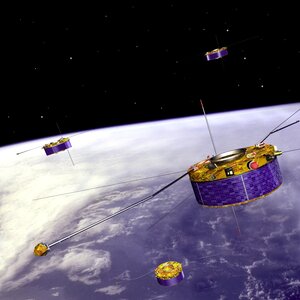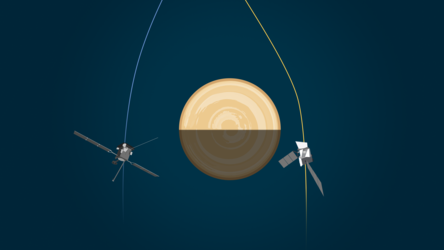M
Mach number
The ratio of the speed of a fluid to the speed of sound in that fluid. If the Mach number is greater than 1, the fluid is moving at a supersonic speed; if the Mach number is greater than 5, the fluid is moving at hypersonic speed.
Magnetic field
Region around a body in which a magnetic force is detected. Fairly weak magnetic fields are generated by dynamo effects inside planets and moons. Magnetic fields more than one billion times stronger may be generated in stars and galaxies. These are capable of controlling the motion of ionised gas and even the shape of objects.
Magnetic force
One of the fundamental forces of Nature. It is a physical phenomenon which arises as a result of moving electric charge and which results in attractive and repulsive forces between objects.
Magnetometer
An instrument for measuring the magnitude and the direction of a magnetic field.
Magnetopause
The outer limit of the magnetosphere, beyond which the magnetic field of a planet is not so relevant in controlling the physical processes taking place.
Magnetosphere
Region surrounding a planet which contains charged particles controlled by the planet's magnetic field.
Magnitude, absolute (M)
How bright a star would appear if it were viewed at a standard distance of 10 parsecs.
Magnitude, apparent (m)
How bright a star appears without any correction made for its distance.
Main sequence
The main sequence of stars on the Hertzsprung-Russell diagram, containing about 90% of all known stars. A star spends most of its life on the main sequence. The position of the star on the main sequence and the time it spends there depends mainly on the mass of the star. More massive stars are found higher on the main sequence, they also have shorter lifetimes.
Mandrel
Metallic structure upon which articles to be turned are placed. Used for example in manufacturing mirrors.
Mantle
Layer inside a planet or moon which lies below the crust and above the core. It is intermediate in temperature and density between these two layers. The Earth's mantle is about 2900 km thick and has an average density of 4.5 g/cm3.
Manufacturing
Process of creating equipment usually with machinery.
Mars
The fourth planet out from the Sun and the furthest out of the terrestrial planets. Mars is about one-tenth the mass of the Earth and has one third of its gravity. It exhibits geological features suggesting that its early history followed a similar path to that of the Earth.
Mass
The total amount of material in a body, a measure of the amount of matter. In his famous equation E=mc2 Albert Einstein stated that mass (m) is equivalent to energy (E) – the two parameters are related via the speed of light (c).
Matter
A physical substance, having mass and occupying space. At its most basic level matter consists of fundamental particles such as electrons and quarks. Quarks are the fundamental building blocks of protons and neutrons which are the components of atomic nuclei.
Measurements (in-situ)
Measurements made in a place to sample the local environment.
Measurements (remote)
Measurement of physical and chemical parameters of a physical object from a remote location.
Mercury
At a distance from the Sun of 0.387 AU, Mercury is the closest planet to our star and the first of the terrestrial planets. Its radius is little more than a third that of the Earth's and it has a very tenuous atmosphere. It is the densest of the planets and gravity at the surface is 3.7 times that of Earth. The average surface temperature is 440 K (170 °C).
Meteor
Brief streak of light seen in the night sky when a speck of dust burns up as it enters the upper atmosphere. Also known as a shooting star or falling star.
Meteor shower
A group of meteors which appear to radiate from the same part of the sky and which occur over a limited period of a few days or hours. Dozens of annual showers are known though only a few give significant regular displays.
Meteorite
A fragment of rock that survives its fall to Earth from space. Usually named after the place where it fell.
Meteoroid
A piece of rock or dust in space with the potential to enter Earth's atmosphere and become a meteor or meteorite.
Methane
A colourless and odourless gas that belongs to the alkane series of the hydrocarbons.
Microgravity
Condition of near-weightlessness experienced by a person or object in free fall as it orbits a star or planet. In a spacecraft orbiting the Earth, gravity is reduced to one ten-thousandth (1/10000) of its value at the planet's surface.
Micron
Unit to measure length. It is often used to measure the wavelength of light. 1 micron is a thousandth of a millimetre. 10 000 micron correspond to 1 centimetre.
Microwave
Light, or electromagnetic radiation, whose wavelength ranges from millimetres to almost one metre. The cosmic microwave background radiation emits strongly in microwaves.
Milky Way
Our Galaxy seen as a misty band of light which stretches across the night sky. The Milky Way contains about one hundred million stars. It has the shape of a disk with a diameter of about 100 000 light-years. The Sun lies about two-thirds of the way towards the edge of the disc from the centre.
Mirror
An optical element that reflects electromagnetic waves (such as visible light, infrared, gamma or X-rays..) towards a camera or detector.
Module (satellite)
Part of a satellite that has been designed and built and often tested as an entity.
Molecular cloud
Clouds of interstellar dust and gas in the molecular form. They can be very large with a diameter of up to a hundred light-years. Most of the gas in these clouds is very cold, only tens of degrees above the absolute zero.
Monitor
Optical instrument used to observe the sky by itself and sometimes as a complement to another instrument.
Moon
(1) The Earth's satellite, which orbits at a distance of 384 500 km. Its mass is one-eightieth (1/80) and its gravity one-sixth (1/6) of the Earth's. Surface temperatures range from 80-400 K. It has no atmosphere.
(2) General name also given to natural satellites, e.g., the moon of Jupiter and Saturn.
Multimirror
Telescope design employing several mirrors to collect and focus electromagnetic waves, as in ESA's XMM-Newton space observatory.
Multi-wavelength (observations)
Observation of a celestial object at different wavelengths, with (possibly) different instruments.















 Germany
Germany
 Austria
Austria
 Belgium
Belgium
 Denmark
Denmark
 Spain
Spain
 Estonia
Estonia
 Finland
Finland
 France
France
 Greece
Greece
 Hungary
Hungary
 Ireland
Ireland
 Italy
Italy
 Luxembourg
Luxembourg
 Norway
Norway
 The Netherlands
The Netherlands
 Poland
Poland
 Portugal
Portugal
 Czechia
Czechia
 Romania
Romania
 United Kingdom
United Kingdom
 Slovenia
Slovenia
 Sweden
Sweden
 Switzerland
Switzerland










































